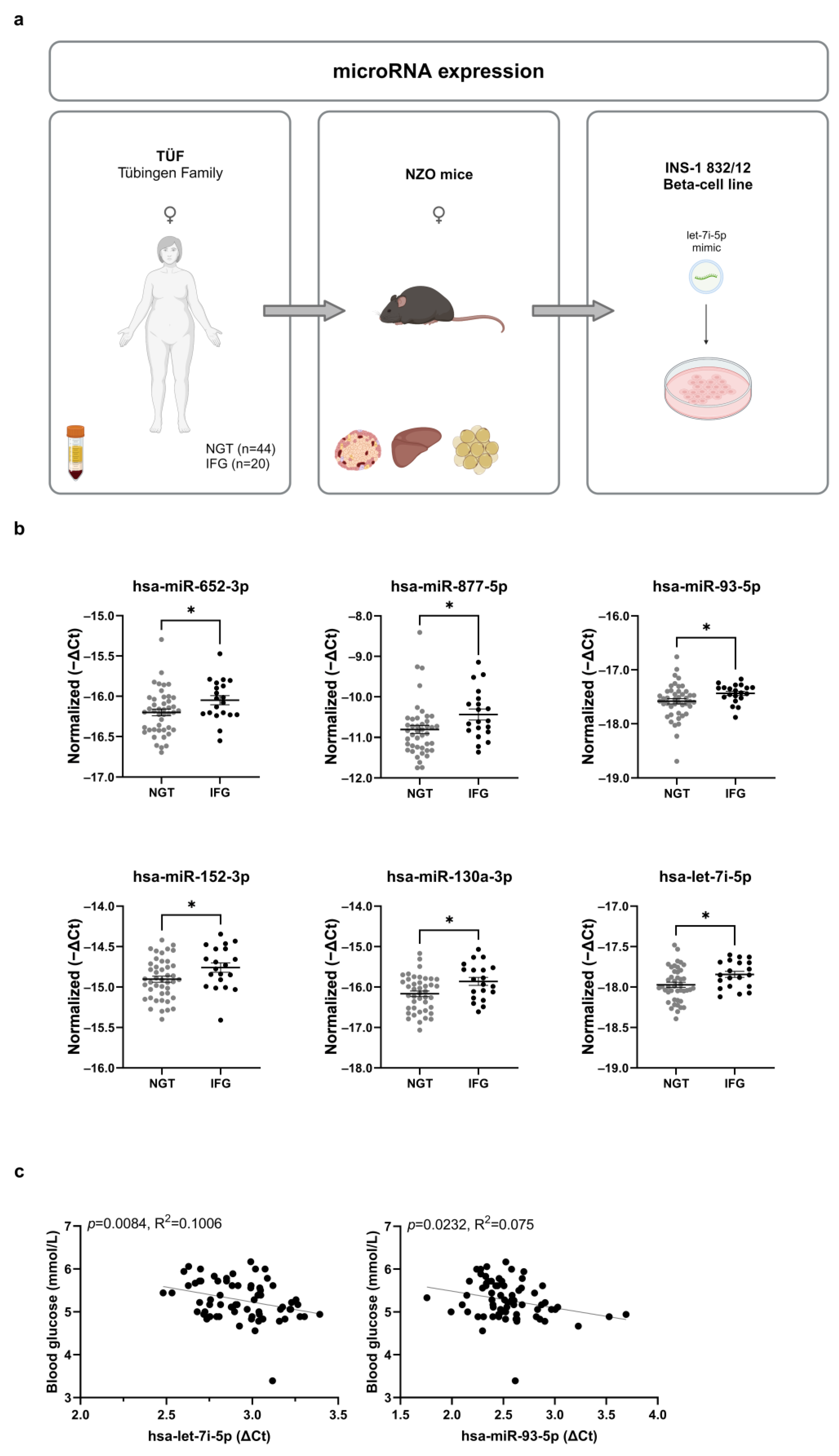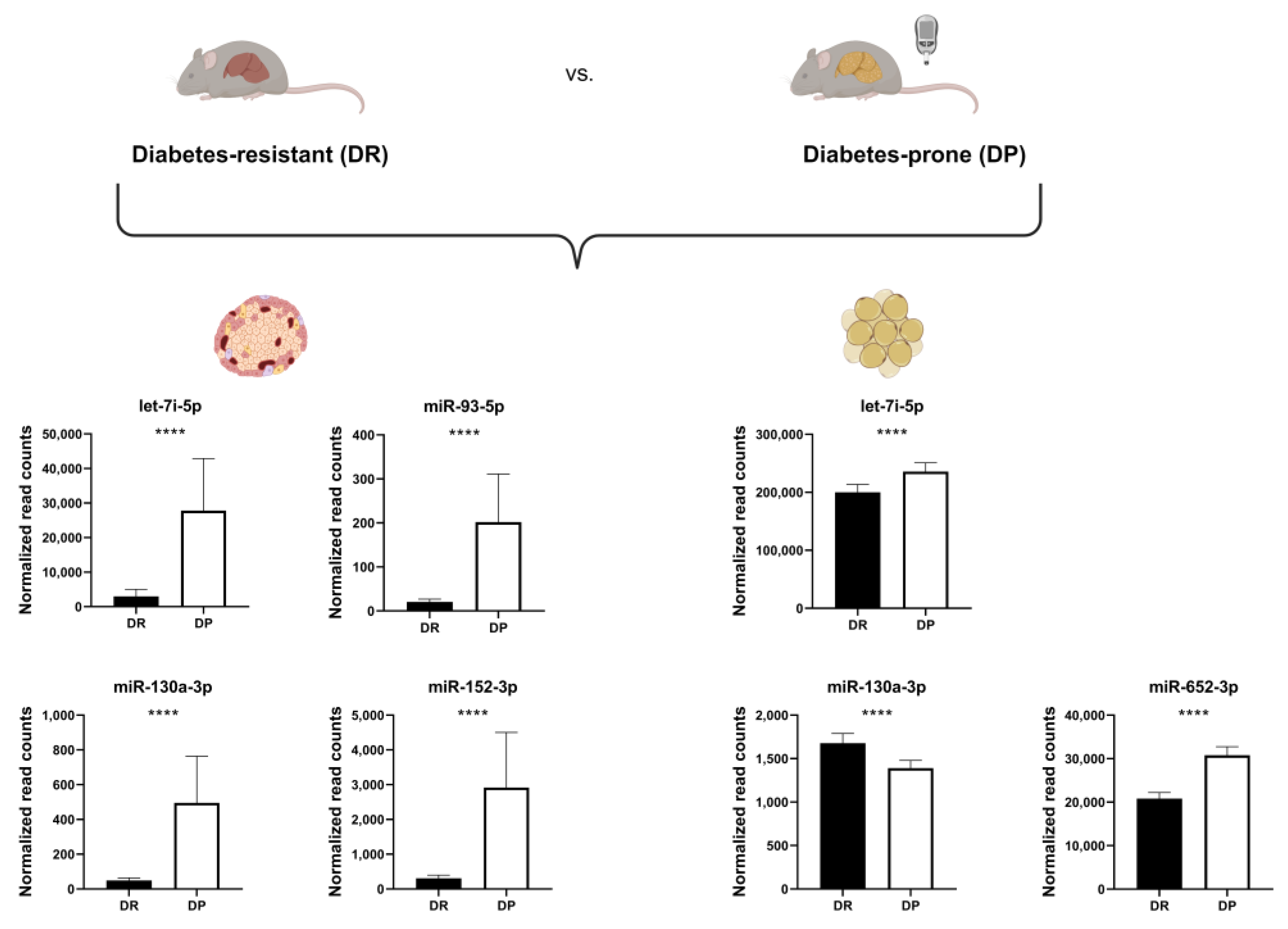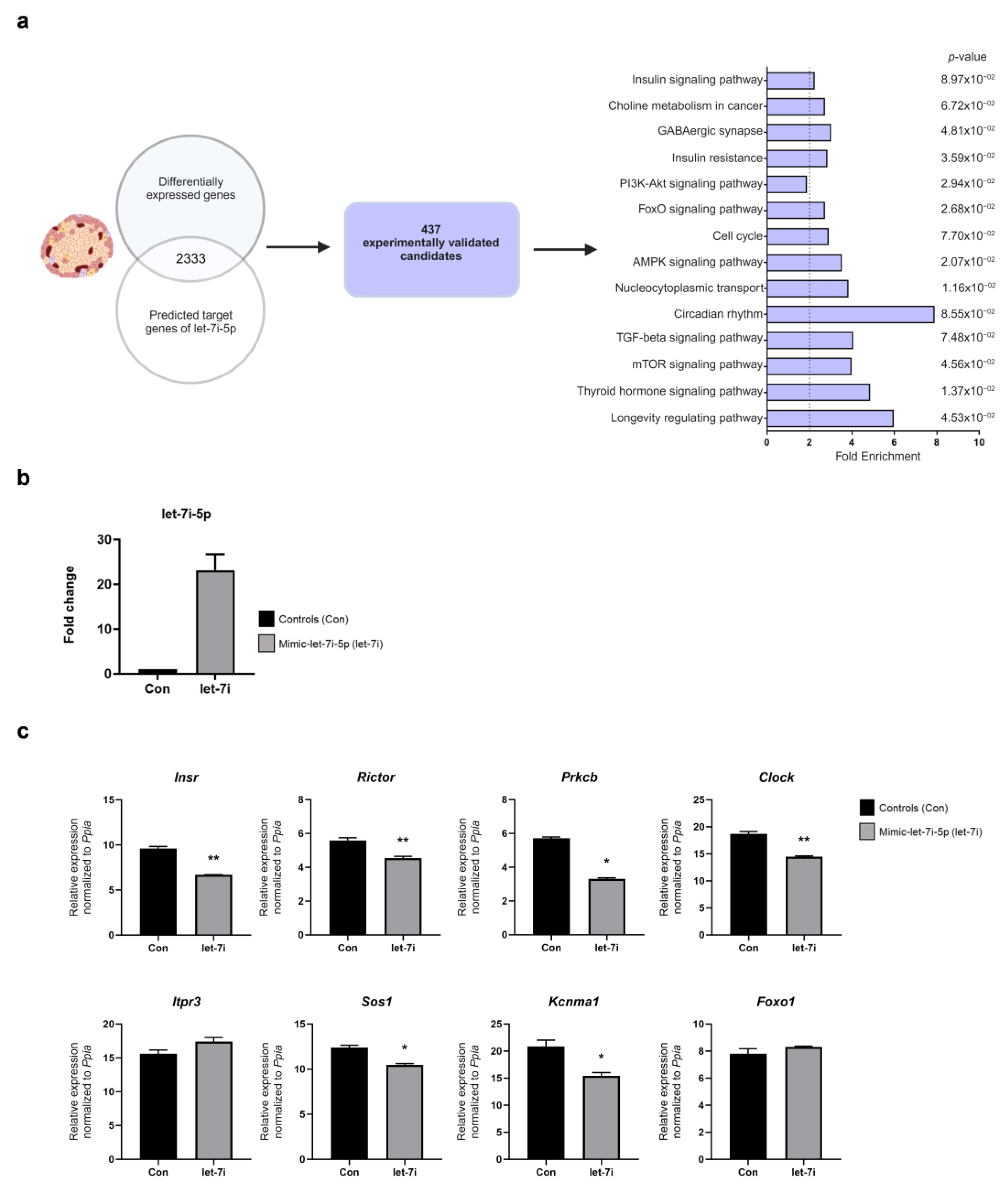Identification of MicroRNAs Associated with Prediabetic Status in Obese Women
Abstract
1. Introduction
2. Results
2.1. Identification of Six miRNAs in Plasma of Women with Prediabetes
2.2. Validation of Candidate miRNA Expression in Metabolically Relevant Tissues
2.3. Increased Expression of let-7i Reduces Expression of Genes Involved in the Insulin Signaling Pathway
3. Discussion
4. Materials and Methods
4.1. Human Participants and Ethics Statement
4.2. Animal Studies
4.3. Pancreatic Islet Isolation and RNA-Sequencing
4.4. miRNA Detection in Human Plasma
4.5. miRNA Detection in Mouse Tissues
4.6. miRNA Target Prediction
4.7. Transfection of INS-1 (832/13) β-Cells
4.8. Prediction of Transcription Factor Binding Sites Regulating let-7i-5p
4.9. RNA Isolation and Quantitative RT-PCR (qRT-PCR) in INS-1 Cells
4.10. Statistics and Plotting
Supplementary Materials
Author Contributions
Funding
Institutional Review Board Statement
Informed Consent Statement
Data Availability Statement
Acknowledgments
Conflicts of Interest
References
- Hivert, M.F.; Vassy, J.L.; Meigs, J.B. Susceptibility to type 2 diabetes mellitus--from genes to prevention. Nat. Rev. Endocrinol. 2014, 10, 198–205. [Google Scholar] [CrossRef] [PubMed]
- Almgren, P.; Lehtovirta, M.; Isomaa, B.; Sarelin, L.; Taskinen, M.R.; Lyssenko, V.; Tuomi, T.; Groop, L.; Botnia Study, G. Heritability and familiality of type 2 diabetes and related quantitative traits in the Botnia Study. Diabetologia 2011, 54, 2811–2819. [Google Scholar] [CrossRef]
- Willemsen, G.; Ward, K.J.; Bell, C.G.; Christensen, K.; Bowden, J.; Dalgard, C.; Harris, J.R.; Kaprio, J.; Lyle, R.; Magnusson, P.K.; et al. The Concordance and Heritability of Type 2 Diabetes in 34,166 Twin Pairs from International Twin Registers: The Discordant Twin (DISCOTWIN) Consortium. Twin Res. Hum. Genet. 2015, 18, 762–771. [Google Scholar] [CrossRef]
- Avery, A.R.; Duncan, G.E. Heritability of Type 2 Diabetes in the Washington State Twin Registry. Twin Res. Hum. Genet. 2019, 22, 95–98. [Google Scholar] [CrossRef] [PubMed]
- Mamtani, M.; Jaisinghani, M.T.; Jaiswal, S.G.; Pipal, K.V.; Patel, A.A.; Kulkarni, H. Genetic association of anthropometric traits with type 2 diabetes in ethnically endogamous Sindhi families. PLoS ONE 2021, 16, e0257390. [Google Scholar] [CrossRef] [PubMed]
- Mahajan, A.; Taliun, D.; Thurner, M.; Robertson, N.R.; Torres, J.M.; Rayner, N.W.; Payne, A.J.; Steinthorsdottir, V.; Scott, R.A.; Grarup, N.; et al. Fine-mapping type 2 diabetes loci to single-variant resolution using high-density imputation and islet-specific epigenome maps. Nat. Genet. 2018, 50, 1505–1513. [Google Scholar] [CrossRef]
- Lacal, I.; Ventura, R. Epigenetic Inheritance: Concepts, Mechanisms and Perspectives. Front. Mol. Neurosci. 2018, 11, 292. [Google Scholar] [CrossRef]
- O’Brien, J.; Hayder, H.; Zayed, Y.; Peng, C. Overview of MicroRNA Biogenesis, Mechanisms of Actions, and Circulation. Front Endocrinol. 2018, 9, 402. [Google Scholar] [CrossRef]
- Geekiyanage, H.; Rayatpisheh, S.; Wohlschlegel, J.A.; Brown, R., Jr.; Ambros, V. Extracellular microRNAs in human circulation are associated with miRISC complexes that are accessible to anti-AGO2 antibody and can bind target mimic oligonucleotides. Proc. Natl. Acad. Sci. USA 2020, 117, 24213–24223. [Google Scholar] [CrossRef]
- Kulaj, K.; Harger, A.; Bauer, M.; Caliskan, O.S.; Gupta, T.K.; Chiang, D.M.; Milbank, E.; Reber, J.; Karlas, A.; Kotzbeck, P.; et al. Adipocyte-derived extracellular vesicles increase insulin secretion through transport of insulinotropic protein cargo. Nat. Commun. 2023, 14, 709. [Google Scholar] [CrossRef]
- Rome, S. Are extracellular microRNAs involved in type 2 diabetes and related pathologies? Clin. Biochem. 2013, 46, 937–945. [Google Scholar] [CrossRef] [PubMed]
- Ouni, M.; Saussenthaler, S.; Eichelmann, F.; Jähnert, M.; Stadion, M.; Wittenbecher, C.; Rönn, T.; Zellner, L.; Gottmann, P.; Ling, C.; et al. Epigenetic changes in islets of langerhans preceding the onset of diabetes. Diabetes 2020, 69, 2503–2517. [Google Scholar] [CrossRef] [PubMed]
- Ouni, M.; Eichelmann, F.; Jahnert, M.; Krause, C.; Saussenthaler, S.; Ott, C.; Gottmann, P.; Speckmann, T.; Huypens, P.; Wolter, S.; et al. Differences in DNA methylation of HAMP in blood cells predicts the development of type 2 diabetes. Mol. Metab. 2023, 75, 101774. [Google Scholar] [CrossRef] [PubMed]
- Gottmann, P.; Ouni, M.; Zellner, L.; Jahnert, M.; Rittig, K.; Walther, D.; Schurmann, A. Polymorphisms in miRNA binding sites involved in metabolic diseases in mice and humans. Sci. Rep. 2020, 10, 7202. [Google Scholar] [CrossRef] [PubMed]
- Chou, C.H.; Chang, N.W.; Shrestha, S.; Hsu, S.D.; Lin, Y.L.; Lee, W.H.; Yang, C.D.; Hong, H.C.; Wei, T.Y.; Tu, S.J.; et al. miRTarBase 2016: Updates to the experimentally validated miRNA-target interactions database. Nucleic Acids Res. 2016, 44, D239–D247. [Google Scholar] [CrossRef] [PubMed]
- Matsha, T.E.; Kengne, A.P.; Hector, S.; Mbu, D.L.; Yako, Y.Y.; Erasmus, R.T. MicroRNA profiling and their pathways in South African individuals with prediabetes and newly diagnosed type 2 diabetes mellitus. Oncotarget 2018, 9, 30485–30498. [Google Scholar] [CrossRef] [PubMed][Green Version]
- Saeidi, L.; Shahrokhi, S.Z.; Sadatamini, M.; Jafarzadeh, M.; Kazerouni, F. Can circulating miR-7-1-5p, and miR-33a-5p be used as markers of T2D patients? Arch. Physiol. Biochem. 2023, 129, 771–777. [Google Scholar] [CrossRef]
- Shahrokhi, S.Z.; Saeidi, L.; Sadatamini, M.; Jafarzadeh, M.; Rahimipour, A.; Kazerouni, F. Can miR-145-5p be used as a marker in diabetic patients? Arch. Physiol. Biochem. 2022, 128, 1175–1180. [Google Scholar] [CrossRef]
- Sadeghzadeh, S.; Dehghani Ashkezari, M.; Seifati, S.M.; Vahidi Mehrjardi, M.Y.; Dehghan Tezerjani, M.; Sadeghzadeh, S.; Ladan, S.A.B. Circulating miR-15a and miR-222 as Potential Biomarkers of Type 2 Diabetes. Diabetes Metab. Syndr. Obes. 2020, 13, 3461–3469. [Google Scholar] [CrossRef]
- Ghai, V.; Baxter, D.; Wu, X.; Kim, T.K.; Kuusisto, J.; Laakso, M.; Connolly, T.; Li, Y.; Andrade-Gordon, P.; Wang, K. Circulating RNAs as predictive markers for the progression of type 2 diabetes. J. Cell. Mol. Med. 2019, 23, 2753–2768. [Google Scholar] [CrossRef]
- Parrizas, M.; Brugnara, L.; Esteban, Y.; Gonzalez-Franquesa, A.; Canivell, S.; Murillo, S.; Gordillo-Bastidas, E.; Cusso, R.; Cadefau, J.A.; Garcia-Roves, P.M.; et al. Circulating miR-192 and miR-193b are markers of prediabetes and are modulated by an exercise intervention. J. Clin. Endocrinol. Metab. 2015, 100, E407–E415. [Google Scholar] [CrossRef] [PubMed]
- Yang, Z.; Chen, H.; Si, H.; Li, X.; Ding, X.; Sheng, Q.; Chen, P.; Zhang, H. Serum miR-23a, a potential biomarker for diagnosis of pre-diabetes and type 2 diabetes. Acta Diabetol. 2014, 51, 823–831. [Google Scholar] [CrossRef] [PubMed]
- Strycharz, J.; Wroblewski, A.; Zieleniak, A.; Swiderska, E.; Matyjas, T.; Rucinska, M.; Pomorski, L.; Czarny, P.; Szemraj, J.; Drzewoski, J.; et al. Visceral Adipose Tissue of Prediabetic and Diabetic Females Shares a Set of Similarly Upregulated microRNAs Functionally Annotated to Inflammation, Oxidative Stress and Insulin Signaling. Antioxidants 2021, 10, 101. [Google Scholar] [CrossRef]
- Yan, Y.X.; Dong, J.; Li, Y.L.; Lu, Y.K.; Yang, K.; Wang, T.; Zhang, X.; Xiao, H.B. CircRNA hsa_circ_0071336 is associated with type 2 diabetes through targeting the miR-93-5p/GLUT4 axis. FASEB J. 2022, 36, e22324. [Google Scholar] [CrossRef] [PubMed]
- Roux, M.; Perret, C.; Feigerlova, E.; Mohand Oumoussa, B.; Saulnier, P.J.; Proust, C.; Tregouet, D.A.; Hadjadj, S. Plasma levels of hsa-miR-152-3p are associated with diabetic nephropathy in patients with type 2 diabetes. Nephrol. Dial. Transplant. 2018, 33, 2201–2207. [Google Scholar] [CrossRef]
- Ofori, J.K.; Salunkhe, V.A.; Bagge, A.; Vishnu, N.; Nagao, M.; Mulder, H.; Wollheim, C.B.; Eliasson, L.; Esguerra, J.L. Elevated miR-130a/miR130b/miR-152 expression reduces intracellular ATP levels in the pancreatic beta cell. Sci. Rep. 2017, 7, 44986. [Google Scholar] [CrossRef]
- Dahlman, I.; Belarbi, Y.; Laurencikiene, J.; Pettersson, A.M.; Arner, P.; Kulyte, A. Comprehensive functional screening of miRNAs involved in fat cell insulin sensitivity among women. Am. J. Physiol. Endocrinol. Metab. 2017, 312, E482–E494. [Google Scholar] [CrossRef]
- Doncheva, A.I.; Romero, S.; Ramirez-Garrastacho, M.; Lee, S.; Kolnes, K.J.; Tangen, D.S.; Olsen, T.; Drevon, C.A.; Llorente, A.; Dalen, K.T.; et al. Extracellular vesicles and microRNAs are altered in response to exercise, insulin sensitivity and overweight. Acta Physiol. 2022, 236, e13862. [Google Scholar] [CrossRef]
- Foruzandeh, Z.; Alivand, M.R.; Ghiami-Rad, M.; Zaefizadeh, M.; Ghorbian, S. Identification and validation of miR-583 and mir-877-5p as biomarkers in patients with breast cancer: An integrated experimental and bioinformatics research. BMC Res. Notes 2023, 16, 72. [Google Scholar] [CrossRef]
- Wang, J.; Liang, Y.; Qin, Y.; Jiang, G.; Peng, Y.; Feng, W. circCRKL, a circRNA derived from CRKL, regulates BCR-ABL via sponging miR-877-5p to promote chronic myeloid leukemia cell proliferation. J. Transl. Med. 2022, 20, 395. [Google Scholar] [CrossRef]
- Kumar, S.; Orlov, E.; Gowda, P.; Bose, C.; Swerdlow, R.H.; Lahiri, D.K.; Reddy, P.H. Synaptosome microRNAs regulate synapse functions in Alzheimer’s disease. NPJ Genom. Med. 2022, 7, 47. [Google Scholar] [CrossRef] [PubMed]
- Ghoreishi, E.; Shahrokhi, S.Z.; Kazerouni, F.; Rahimipour, A. Circulating miR-148b-3p and miR-27a-3p can be potential biomarkers for diagnosis of pre-diabetes and type 2 diabetes: Integrating experimental and in-silico approaches. BMC Endocr. Disord. 2022, 22, 207. [Google Scholar] [CrossRef] [PubMed]
- Zhu, L.; Jing, J.; Qin, S.; Zheng, Q.; Lu, J.; Zhu, C.; Liu, Y.; Fang, F.; Li, Y.; Ling, Y. miR-130a-3p regulates steroid hormone synthesis in goat ovarian granulosa cells by targeting the PMEPA1 gene. Theriogenology 2021, 165, 92–98. [Google Scholar] [CrossRef] [PubMed]
- Xu, X.; Zhang, P.; Li, X.; Liang, Y.; Ouyang, K.; Xiong, J.; Wang, D.; Duan, L. MicroRNA expression profiling in an ovariectomized rat model of postmenopausal osteoporosis before and after estrogen treatment. Am. J. Transl. Res. 2020, 12, 4251–4263. [Google Scholar] [PubMed]
- Song, J.; Ma, X.; Li, F.; Liu, J. Exposure to multiple pyrethroid insecticides affects ovarian follicular development via modifying microRNA expression. Sci. Total Environ. 2022, 828, 154384. [Google Scholar] [CrossRef] [PubMed]
- Kolacinska, A.; Morawiec, J.; Pawlowska, Z.; Szemraj, J.; Szymanska, B.; Malachowska, B.; Morawiec, Z.; Morawiec-Sztandera, A.; Pakula, L.; Kubiak, R.; et al. Association of microRNA-93, 190, 200b and receptor status in core biopsies from stage III breast cancer patients. DNA Cell Biol. 2014, 33, 624–629. [Google Scholar] [CrossRef] [PubMed]
- Moi, L.; Braaten, T.; Al-Shibli, K.; Lund, E.; Busund, L.R. Differential expression of the miR-17-92 cluster and miR-17 family in breast cancer according to tumor type; results from the Norwegian Women and Cancer (NOWAC) study. J. Transl. Med. 2019, 17, 334. [Google Scholar] [CrossRef]
- Wu, Q.; Guo, L.; Jiang, F.; Li, L.; Li, Z.; Chen, F. Analysis of the miRNA-mRNA-lncRNA networks in ER+ and ER- breast cancer cell lines. J. Cell. Mol. Med. 2015, 19, 2874–2887. [Google Scholar] [CrossRef]
- Oztemur Islakoglu, Y.; Noyan, S.; Aydos, A.; Gur Dedeoglu, B. Meta-microRNA Biomarker Signatures to Classify Breast Cancer Subtypes. OMICS 2018, 22, 709–716. [Google Scholar] [CrossRef]
- Bozkurt, S.B.; Ozturk, B.; Kocak, N.; Unlu, A. Differences of time-dependent microRNA expressions in breast cancer cells. Noncoding RNA Res. 2021, 6, 15–22. [Google Scholar] [CrossRef]
- Zhao, Y.; Deng, C.; Lu, W.; Xiao, J.; Ma, D.; Guo, M.; Recker, R.R.; Gatalica, Z.; Wang, Z.; Xiao, G.G. let-7 microRNAs induce tamoxifen sensitivity by downregulation of estrogen receptor alpha signaling in breast cancer. Mol. Med. 2011, 17, 1233–1241. [Google Scholar] [CrossRef]
- Zhang, H.; Chen, T.; Xiong, J.; Hu, B.; Luo, J.; Xi, Q.; Jiang, Q.; Sun, J.; Zhang, Y. MiR-130a-3p Inhibits PRL Expression and Is Associated with Heat Stress-Induced PRL Reduction. Front. Endocrinol. 2020, 11, 92. [Google Scholar] [CrossRef] [PubMed]
- Fan, Q.; Huang, T.; Sun, X.; Yang, X.; Wang, J.; Liu, Y.; Ni, T.; Gu, S.; Li, Y.; Wang, Y. miR-130a-3p promotes cell proliferation and invasion by targeting estrogen receptor alpha and androgen receptor in cervical cancer. Exp. Ther. Med. 2021, 21, 414. [Google Scholar] [CrossRef] [PubMed]
- Xu, X.; Shen, H.R.; Yu, M.; Du, M.R.; Li, X.L. MicroRNA let-7i inhibits granulosa-luteal cell proliferation and oestradiol biosynthesis by directly targeting IMP2. Reprod. Biomed. Online 2022, 44, 803–816. [Google Scholar] [CrossRef] [PubMed]
- Nweke, E.E.; Brand, M. Downregulation of the let-7 family of microRNAs may promote insulin receptor/insulin-like growth factor signalling pathways in pancreatic ductal adenocarcinoma. Oncol. Lett. 2020, 20, 2613–2620. [Google Scholar] [CrossRef] [PubMed]
- Langi, G.; Szczerbinski, L.; Kretowski, A. Meta-Analysis of Differential miRNA Expression after Bariatric Surgery. J. Clin. Med. 2019, 1220. [Google Scholar] [CrossRef] [PubMed]
- Nielsen, S.; Akerstrom, T.; Rinnov, A.; Yfanti, C.; Scheele, C.; Pedersen, B.K.; Laye, M.J. The miRNA plasma signature in response to acute aerobic exercise and endurance training. PLoS ONE 2014, 9, e87308. [Google Scholar] [CrossRef]
- Keller, A.; Groger, L.; Tschernig, T.; Solomon, J.; Laham, O.; Schaum, N.; Wagner, V.; Kern, F.; Schmartz, G.P.; Li, Y.; et al. miRNATissueAtlas2: An update to the human miRNA tissue atlas. Nucleic Acids Res. 2022, 50, D211–D221. [Google Scholar] [CrossRef]
- Ortega, F.J.; Mercader, J.M.; Moreno-Navarrete, J.M.; Rovira, O.; Guerra, E.; Esteve, E.; Xifra, G.; Martinez, C.; Ricart, W.; Rieusset, J.; et al. Profiling of circulating microRNAs reveals common microRNAs linked to type 2 diabetes that change with insulin sensitization. Diabetes Care 2014, 37, 1375–1383. [Google Scholar] [CrossRef]
- Schmid, V.; Wagner, R.; Sailer, C.; Fritsche, L.; Kantartzis, K.; Peter, A.; Heni, M.; Haring, H.U.; Stefan, N.; Fritsche, A. Non-alcoholic fatty liver disease and impaired proinsulin conversion as newly identified predictors of the long-term non-response to a lifestyle intervention for diabetes prevention: Results from the TULIP study. Diabetologia 2017, 60, 2341–2351. [Google Scholar] [CrossRef]
- Saussenthaler, S.; Ouni, M.; Baumeier, C.; Schwerbel, K.; Gottmann, P.; Christmann, S.; Laeger, T.; Schurmann, A. Epigenetic regulation of hepatic Dpp4 expression in response to dietary protein. J. Nutr. Biochem. 2019, 63, 109–116. [Google Scholar] [CrossRef]
- Zhang, H.; Meltzer, P.; Davis, S. RCircos: An R package for Circos 2D track plots. BMC Bioinform. 2013, 14, 244. [Google Scholar] [CrossRef]



| NGT | IFG | |
|---|---|---|
| N | 44 | 20 |
| Age (years) | 49.8 ± 11 | 49 ± 13.0 |
| BMI (kg/m2) | 32 ± 5 | 31 ± 3.6 |
| Fasting blood glucose (mmol/L) | 5.0 ± 0.2 | 5.8 ± 0.2 **** |
| Blood glucose 120 min after glucose bolus during OGTT (mmol/L) | 6.0 ± 0.9 | 6.3 ± 0.8 |
Disclaimer/Publisher’s Note: The statements, opinions and data contained in all publications are solely those of the individual author(s) and contributor(s) and not of MDPI and/or the editor(s). MDPI and/or the editor(s) disclaim responsibility for any injury to people or property resulting from any ideas, methods, instructions or products referred to in the content. |
© 2023 by the authors. Licensee MDPI, Basel, Switzerland. This article is an open access article distributed under the terms and conditions of the Creative Commons Attribution (CC BY) license (https://creativecommons.org/licenses/by/4.0/).
Share and Cite
Kovac, L.; Speckmann, T.; Jähnert, M.; Gottmann, P.; Fritsche, L.; Häring, H.-U.; Birkenfeld, A.L.; Fritsche, A.; Schürmann, A.; Ouni, M. Identification of MicroRNAs Associated with Prediabetic Status in Obese Women. Int. J. Mol. Sci. 2023, 24, 15673. https://doi.org/10.3390/ijms242115673
Kovac L, Speckmann T, Jähnert M, Gottmann P, Fritsche L, Häring H-U, Birkenfeld AL, Fritsche A, Schürmann A, Ouni M. Identification of MicroRNAs Associated with Prediabetic Status in Obese Women. International Journal of Molecular Sciences. 2023; 24(21):15673. https://doi.org/10.3390/ijms242115673
Chicago/Turabian StyleKovac, Leona, Thilo Speckmann, Markus Jähnert, Pascal Gottmann, Louise Fritsche, Hans-Ulrich Häring, Andreas L. Birkenfeld, Andreas Fritsche, Annette Schürmann, and Meriem Ouni. 2023. "Identification of MicroRNAs Associated with Prediabetic Status in Obese Women" International Journal of Molecular Sciences 24, no. 21: 15673. https://doi.org/10.3390/ijms242115673
APA StyleKovac, L., Speckmann, T., Jähnert, M., Gottmann, P., Fritsche, L., Häring, H.-U., Birkenfeld, A. L., Fritsche, A., Schürmann, A., & Ouni, M. (2023). Identification of MicroRNAs Associated with Prediabetic Status in Obese Women. International Journal of Molecular Sciences, 24(21), 15673. https://doi.org/10.3390/ijms242115673





